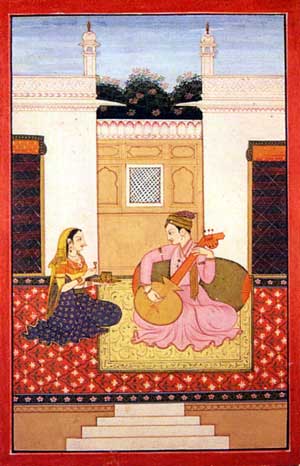(Alhiya Bilawal)

Description
It is difficult to describe both the popularity as well as the precise definition of this rag. The difficulty results from a lack of agreement as to how much latitude we wish to extend.
If we wish to be very restrictive in its definition, Bilawal is sometimes referred to as Shuddha Bilawal. This name is chosen to suggest this restrictive approach. But there is often confusion as to what this means. Some suggest that Shuddha Bilawal is really Lom Bilawal; some suggest Alhiya Bilawal; while others put forth entirely different structures. The plurality of opinion has Bilawal as being the same as Alhiya Bilawal. This is the position that we will take here. Regardless of our nomenclature, according to this restrictive definition, Bilawal has been declining in popularity over the years.
If this all seems confusing, the reason is that it IS confusing. A few “purists” and scholars will argue over this without ever reaching a resolution. Therefore, most people take a more relaxed approach to the definition of Bilawal.
A very different picture emerges if we wish to take a more relaxed approach. This accrues from the fact that a more relaxed definition encompasses the Western natural scale. The ubiquity of this scale in popular Indian music makes Bilawal the most popular scale in India.
Bilawal is considerd by most to be Sampurna – Sampurna. However, some are of the opinion that it should be considered Shadav – Sampurna due to the weakness of its Ga in the arohana.
The vadi / samavadi theory is generally discounted by modern musicologists, but for those who are inclined to follow this, it has been suggested that the vadi and samavadi are Dha and Re respectively.
Bilawal is a very flexible rag, capable invoking a variety of moods. In the Sikh tradition, it is said that it is particularly effective in conveying a mood of happiness.
Arohana

(general discussion of arohana) – (general discussion of notation)
Avarohana

(general discussion of avarohana)
Jati
Sampurna – Sampurna – (general discussion of jati)
Vadi
Dha – (general discussion of vadi)
Samvadi
Re – (general discussion of samvadi)
Time
Morning – (general discussion of time and rag)
That
Bilawal that – (general discussion of that)
Drone
Sa – Pa – (general discussion of drone)
Popular Songs
For more information check out “Elementary North Indian Vocal: Vol 1” and “Elementary North Indian Vocal: Vol 2”
Selected Video
Other Sites of Interest
Indian Classical Music: Tuning and Ragas
Modes and Ragas: More Than just a Scale
Emotional responses to Hindustani Raga music: The role of musical structure
Automatic Raga Recognition in Hindustani Classical Music
Patrick Moutal. A Comparative Study of Selected Hindustānī Rāga-s based on Contemporary Practice
Automatic Tonic Identification in Indian Art Music: Approaches and Evaluation
